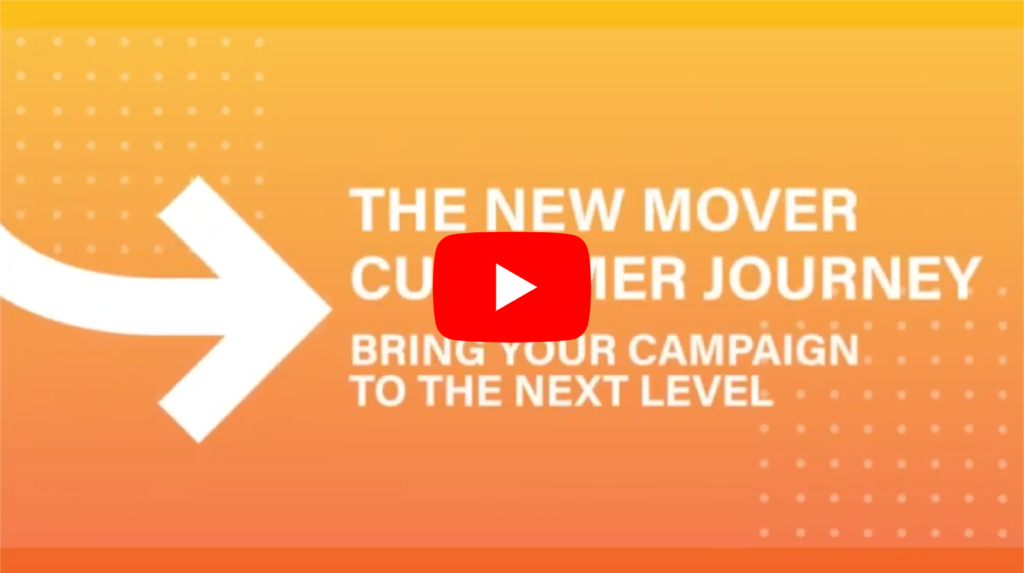All Your Questions Answered
There’s a lot of buzz around new mover marketing and the best ways to target potential new customers. And with all the attention and noise around it, the topic can get confusing and leave a lot of essential questions unanswered. Today, we’re going to answer all your questions about new mover marketing – and give you some insight into how to start a successful and smart new mover campaign.
Why should I target new movers in the first place?
Easy answer. With over 13% of Americans moving ever year, a ton of new movers are not only new to your area, but are looking for your business. They’re in a stage where they’re starting to develop what will become habitual shopping/buying habits and not looking for a reason to spend, but where to spend. Recent surveys show that 80% of new movers are willing to try new products since they’re in a new market and searching for new businesses and services. Also, how else are you going to replace those long-term, current clients that are moving out of your market area?
In what industries is new mover marketing effective?
Movers moving into a new house spend on average, $9,400 post-move, and that’s split into several different industries depending on the individual. When people move to new areas, they have several new (and already existing) needs that can only be met by several different industries. This means a new grocer, new healthcare provider, new dentist, new restaurants, a new gym… list goes on and on (and on).
Is it possible to segment who I target?
Yes, you can segment who you’re targeting based off age, demographic, and even by household income, to identify your ideal customer profile. The level of available segmentation depends on your new mover marketing partner and the technology that’s provided, but it can (and has been) done.
Can I have more than one touch point across several channels?
Absolutely! We recommend implementing multiple touch points that come from different angles. This means reaching your customers through several different channels, such as digital, direct mail, and email. All of these channels of communication, used together and correctly, are proven to show effective ROI.
How can I grow my new mover market through direct mail?
With around 61% of customers finding direct mail influential in making purchasing decisions, it’s important to make it one of the cornerstones of your new mover marketing campaigns. Direct mail can be personalized for the consumer, be authentic to your brand, and provides opportunity to be creative with how you market products and services to your consumers. Mailers that typically work best for new movers are dimensional mail, postcards, and bi-folds with incentive items.
How can I grow my new mover customer base with digital ads?
Hand in hand with direct mail, digital ads are excellent in getting your company’s name across your potential customer’s device. Creating display and banner advertisements is an effective way to send customers to your website or to a specific landing page. The power of digital marketing often speaks for itself, so it’s important to have elements of it involved in your new mover marketing campaign to reach all potential customers – not just some.
What kinds of responses should I expect throughout my campaign?
This all depends on the structure of your campaign and what kind of responses you’re aiming for. For instance, if you include a business reply card (BRC) within your direct mailer, your response rate will be based off how many potential customers fill them out and return them. Furthermore, the more aggressive your offer is for a direct response, the greater the response will be. Responses typically vary between industry and how many different touch points are built into your campaign. Response rates can also be determined by digital ads based off the number of consumers that interact with your landing page by clicks or submitted forms.
What’s the best way to track responses from my campaign?
When executing a new mover marketing campaign, make sure the program you’re using can easily track all progress, responses, and data that comes with the campaign. Find a partner with access to technology that allows you to see real time responses for your campaign and gain intelligence from those responses to make adjustments as it’s executed.
How do I effectively set up a new mover marketing campaign?
Picking the right partner is everything when it comes to successfully setting up a new mover marketing campaign. The right partner will provide the right data, the right technology, and a partnership with strong content creators who will represent your brand correctly. Work with a company that understands your markets and has several years of experience.
Looking for ways to incorporate a new mover marketing strategy into your next campaign? Here at Strata, we have years and years (and years) of experience under our belts. We’re here to assist you with all your new mover marketing questions and needs. Contact us today.
Bring Your Campaign to the Next Level
With over 40 million people moving every year, there’s a huge market for new customers moving into your target area. That said, many businesses have no idea where to start when it comes to targeting and reaching these new movers. Today, we’ll give you an overview of what new mover marketing is, the customer journey that a new mover takes, and the best channels and campaigns to reach them. Let’s dive in!
From Movers to Buyers
One of the most important things to realize about new movers is that they’re currently nobody’s loyal customer (yet). They’re a key group to target because they’re open to new businesses and products, and on average, develop 72 or more new business relationships within one year of moving. They’re also 5 times more loyal than your regular customer due to being new to the area. Once they find something they like, they’re willing to frequently buy it with ease. Making up 17% of the U.S. population, you can’t afford to miss these walking (and unpacking) opportunities. So, how are their (frequently loyal) buying habits formed? New movers are heavily influenced by timing. Whether you contact them before or after their move decides how they feel about your communication, and what they’ll do about it…
Pre-Move Buying Habits
Data shows that movers begin to stock up on home items right before they move. Products such as kitchen utensils, light fixtures, and everyday household tools are high on their list during this pre-move time.
Post-Move Buying Habits
After their move, new home buyers are likely to spend an average of $9,400, while renters spend around $4,700. Still, this number varies with age, area and demographic. Most of these buying decisions are made within the first few months of moving, which makes it the best time for your company to make contact, introduce yourself, and showcase your product.
A new mover’s first purchases will depend on their personal needs and priorities. For instance, a mover with medical needs may find a doctor immediately, while a mover with a large family may first find a new grocery store. Either way, they’ll have to find both eventually – and it’s likely they will within the first few months. Thankfully, new movers don’t need to be convinced to buy (they’re already more than ready), you’ll just need to convince them to make the right buy (from your company).
Staying in Touch
It’s not only important to get in touch with these potential loyal customers, but to stay in touch. After making a strong first impression, you’ll want to make more points of contact to ensure your company stays top of mind. It’s essential you have a good combination of marketing across several channels that are strategically picked and placed.
New Mover Marketing Tactics
There are several ways to reach these new movers, first, but since we’re experts – we’ll tell you the best ones. First is direct mail. Direct mail ideally arrives at the same time or a few days after new movers enter your neighborhood. Delivering direct mail that welcomes and attracts the new mover while introducing your business is a great way to begin an ongoing relationship. And the stats back this up – as 40% of consumers try new businesses after receiving direct mail. Direct mail is perfect as a first touch to new movers, as it’s personalized, meets them in their new home, and catches them at the right time.
A great way to ensure this direct mail delivers ROI is through BRCs (business reply cards) or eBRCs with incentives. A BRC is a vehicle that allows a prospective customer to provide information to send back to your business, and if incentivized, can return high response rates and bring you valuable customer data.
What’s the next best channel for reaching new movers? Digital advertising. Hand in hand with direct mail, digital ads can create brand awareness, link to your chosen landing page, and target specific online audiences. Digital advertisement placement and audience targeting are the top optimization tactics used by advertisers today.
Email is next – and combined with both direct mail and digital ads, email can be that final touch that brings your company new customers. Using either the BRC information or engagement with digital ads, emails are easy to obtain, making it almost effortless to add new customers to your automated or personalized promotional email campaigns.
The Visible Influence
New mover marketing allows marketers to influence movers’ buying decisions from the beginning of their move all the way until they walk into your doors. It’s about building immediate and vital relationships – because once a new mover buys from you and your shop, they’re 90% more likely to become a repeat customer.
If you want to dig even deeper, it’s smart to use a program that gives your business insight into your customers – such as live statistics and touchpoint behaviors. These meaningful insights will allow your shop to make enhancements on the fly and improve your campaigns, ultimately increasing ROI.
If you successfully target new movers, create convenient touchpoints that meet their needs, and maintain conversation as they have questions and reach out, the new mover will not only finish their journey as a customer, but as a loyal, repeat one. Looking for ways to incorporate a new mover marketing strategy into your next campaign? With years and years (and years) of experience under our belts, we’re new mover marketing experts. Contact us today.
5 Tips & Tricks to Enhance Your Digital Campaigns
Last week, in our first blog of the Power of Digital series, we discussed how powerful and plentiful digital is in our increasingly technological world. This week, in part 2, we’re giving you a few tried and true digital tips and tricks that businesses can use to increase the power of their marketing.
1. Set Goals
When creating an effective and accurate digital campaign, it’s very important to create goals early, and define them with purpose. Loosely defined goals will just lead you to a loosely defined, unsuccessful campaign, so outlining measurable goals should be your first step. Many companies use the SMART method to develop these goals (specific, measurable, achievable, relevant, and time-based) because it ensures you hit every key factor of effective goal-setting. While many goals should be focused on sales and leads, they can also be set around other variables, such as increasing social media followers, email subscribers, and/or engagement. A recent Harvard Business study revealed amazing statistics relating to goal setting and success. It found that the 14% of people who have goals are 10 times more successful than those without goals – so set, and don’t forget.
2. Define Demographics & Use Personalization
Your online audience heavily varies based on a lot of different factors, such as gender, age, location, income, and more. Since there’s such a large range of possible digital viewers, it’s important to research, define, and customize based on your specific audience. Creating personalized marketing that caters to each demographic is the most effective approach when it comes to digital campaigns, so once you’ve defined your specific target audience, think about what will resonate with them, and incorporate that into your copy, images, and overall strategy.
3. Know (& Use) Your Voice
Again, knowing your audience is key, and if you know them well, you’ll know how to speak to them. If your social media posts or emails look like those of every other company, you’re doing your digital wrong. You won’t catch their attention if you blend into the vast digital crowd. Make sure your content and messaging are relevant, consistent, and always showcases your brand voice and brand story. Also, it’s important to make sure everyone in your company has a good idea of this brand voice, so that your salespeople, staff, and representatives showcase it correctly and authentically. Developing brand voice standards and distributing them will help ensure these are streamlined all over digital – and in the physical world. Over time, as your audience and goals are bound to change, these standards may change, so make sure to always adapt your messaging.
4. Include Clear Call-to-Actions
Call-to-actions can be just as important as the digital campaign itself. Emails with a single call-to-action increased clicks 371% and sales 1617%. Don’t forget to brainstorm, discuss, and review them to perfection. Whatever you want your customer to do when they see your display ad, read your email, or scan your social, make sure it’s obviously displayed. Don’t make them guess. Your call-to-action should be front and center, easy to find and direct. The first word of your call-to-action should be first-person oriented and action oriented. And, like we said, make sure you focus on the language of the call-to-action and ensure it’s clearly connected to your brand as well as your products and services. Avoid generic call-to-actions like “read more” or “learn more here” – as customers are so bogged down by these and not enticed by them anymore. Try other, more unique phrases like “Try for free”, “Join us”, or “Give it a go”.
5. Design Effectively
Digital campaigns leave a ton of room (literally, endless room) for creativity, but make sure to use that design space thoughtfully and effectively. It’s essential you think about not only what the digital campaign is, but where it’s going. It’s likely your users are absorbing your campaign touchpoints in more than one place (on phones, tablets, or laptop screens), and that it’s surrounded by other images and advertising – so make sure it fits, and make sure it pops. To stand out, use high-quality images, unique brand elements, and enticing content that is relevant and consistent to further reinforce your positioning and brand experience. If you’re not certain something will work, still try it! The best campaigns are sometimes the most out-of-the-box, and A/B testing can be used to give new ideas a try.
If you’re ready to take your next digital marketing campaign to the next level, contact Strata today.
Make a Mint off of Print
In last week’s blog, part 1 of the Power of Print series, we discussed how powerful print marketing really is, and how beneficial it can be as a central branding and promotional tool. This week, we have for you, part 2 of the series. Now that you’re convinced of its importance and relevance, we’re giving you key tips and tricks your business can use to enhance the power of your print marketing.
We know you’re busy, and you likely want to save all the time you have for productive business efforts and possibly some great marketing, so, we’re making this a quick and easy read. Like we said, we have more than a few (8, to be exact) top practices to create effective print marketing materials…
8 Ways to Improve the Power of Your Print
Know Your Audience
Any print material you distribute should be at least somewhat personalized and developed with your key audience in mind. Make sure your messaging and visuals speak to the people you’d like to reach above all else. Before even creating your print marketing materials, take time to research and understand your audience, looking into not just their wants and needs, but also their pain points and expectations.
Don’t Push Design Aside
You may think design can come as an afterthought – the last piece of pulling it all together and getting your marketing printed, but the total opposite should take place. Think through your visuals just as you would your content and call outs. Use them to connect with your audience and grab their attention. And, don’t skimp. Print’s already very cost effective, so spending that extra bit on design, paper, and colors is worth it, and could be the reason your audience starts to love your brand or continues to be loyal.
Have a Clear Message
When you’re dealing with print, there’s usually a limited amount of space available, at least compared to digital. There’s not as much room to “say it”, so your forced to “say it right” (which can be a great thing when determining necessary messaging to entice customers with fleeting attention spans). Make sure your message, especially your call to action (what you want the customer to do or know) is loud and clear – not hard to find. Don’t clump all of your products into one postcard. Instead, feature a few products, or better yet, use data to personalize the material and feature that specific customer’s favorite merchandise.
Make it Relevant
We’d like to reiterate – because of just how important it is – to always research, understand, and consider your target demographic before creating print materials. Why would your product or service interest them? Why would they need it? How could your material catch their eye? Personalizing this content will make it much more memorable and impactful. In fact, in a study conducted in 2019, 72% of consumers claimed they only engaged with marketing messages that were customized to their specific interests.
Engage the Senses
When it comes to creating print marketing, don’t just think about what the eyes can see. Print marketing is very much a multi-sensory experience. Consider textures, sounds, and scents (yes, scents!) that evoke feelings within your customer – whether those feelings are excitement, envy, importance, or nostalgia. Incorporating a three-dimensional effect, such as a texture, embossing, or thicker areas of material, can help your print marketing stand out among the rest.
Use a Call to Action (CTA)
Like we said before, you want your call to action to be loud and clear. You don’t want your potential customer setting down your print material without clarity on what you’d like them to do. Make sure to include your address, phone number, and any other applicable contact information like an email address or social account(s). Consider including a coupon for them to use or a sign up for a rewards program, subscription, or membership.
Combine it with Digital
Gain trust and credibility by incorporating digital touches within your print marketing, like QR codes, PURLs, social accounts, and other web references. The best part? Doing so will make campaign attribution a breeze, and will make it easier for you to follow up with interested customers.
Pick the Perfect Printer
The last step of any print marketing process is finding the right printing company to work or partner with – that has affordable yet reasonable rates – and quality print products. Seek out a company that will not only print your materials, but will care about your bottom line and success (almost) as much as you do. They’ll likely offer a variety of printing options, and will have a creative vision for your campaign and/or overall marketing.
Not to toot our own horn (okay, maybe a little), but at Strata, we’re print experts and it’s in our DNA. We’re prepared to work with you whenever you’re ready to brainstorm your next print marketing project. Just contact us when you’re prepared to make smart happen.






